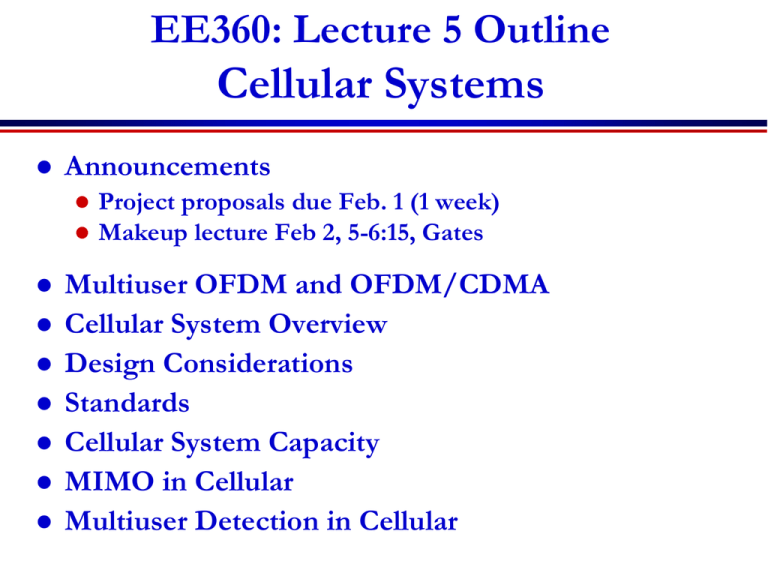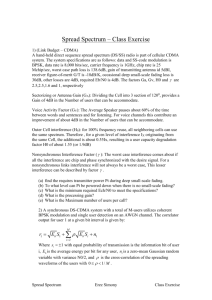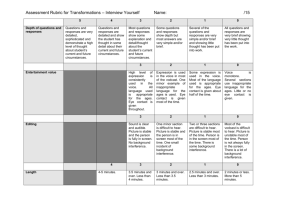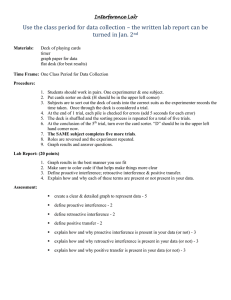Wireless Communications Research Overview
advertisement

EE360: Lecture 5 Outline Cellular Systems Announcements Project proposals due Feb. 1 (1 week) Makeup lecture Feb 2, 5-6:15, Gates Multiuser OFDM and OFDM/CDMA Cellular System Overview Design Considerations Standards Cellular System Capacity MIMO in Cellular Multiuser Detection in Cellular Multiuser OFDM MCM/OFDM divides a wideband channel into narrowband subchannels to mitigate ISI In multiuser systems these subchannels can be allocated among different users Orthogonal allocation: Multiuser OFDM Semiorthogonal allocation: Multicarrier CDMA Adaptive techniques increase the spectral efficiency of the subchannels. Spatial techniques help to mitigate interference between users OFDM OFDM overlaps substreams Substreams separated in receiver Minimum substream separation is B/N, total BW is B 2B/N f0 Efficient IFFT structure at transmitter fN Similar FFT structure at receiver Subcarrier orthogonality must be preserved Impaired by timing jitter, frequency offset, and fading. OFDM-FDMA (a.k.a. OFDMA) Used by the CATV community Used to send upstream data from subscriber to cable head-end. Assigns a subset of available carriers to each user f Adaptive OFDM-FDMA Different subcarriers assigned to different users Assignment can be orthogonal or semiorthogonal fN f0 The fading on each individual subchannel is independent from user to user Adaptive resource allocation gives each their “best” subchannels and adapts optimally to these channels Multiple antennas reduces interference when multiple users are assigned the same subchannels Adaptive Resource Allocation Orthogonal Subcarrier Allocation Degrees of freedom Subcarrier allocation Power Rate Coding BER Optimization goals (subject to power constraint): Maximize the sum of average user rates Find all possible average rate vectors (“capacity” region) Find average rate vectors with minimum rate constraints Minimize power for some average rate vector Minimize outage probability for some constant rate vector. OFDM-TDMA Each user sequentially sends one or more OFDM symbols per frame A single OFDM-TDMA frame: ... User 1 User 2 ... User N-2 User N-1 User N ... Multiuser OFDM with Multiple Antennas Multiple antennas at the transmitter and receiver can greatly increase channel capacity Multiple antennas also used for spatial multiple access: Methods of spatial multiple access Users separated by spatial signatures (versus CDMA time signatures) Spatial signatures are typically not orthogonal May require interference reduction (MUD, cancellation, etc.) Singular value decomposition Space-time equalization Beamsteering OFDM required to remove ISI ISI degrades spatial signatures and interference mitigation CDMA-based schemes Can combine concepts of CDMA and OFDM Reap the benefits of both techniques In 1993, three slightly different schemes were independently proposed: MC-CDMA (Yee, Linnartz, Fettweis, and others) Multicarrier DS-CDMA (DaSilva and Sousa) MT-CDMA (Vandendorpe) Multicarrier CDMA Multicarrier CDMA combines OFDM and CDMA Idea is to use DSSS to spread a narrowband signal and then send each chip over a different subcarrier DSSS time operations converted to frequency domain Greatly reduces complexity of SS system FFT/IFFT replace synchronization and despreading More spectrally efficient than CDMA due to the overlapped subcarriers in OFDM Multiple users assigned different spreading codes Similar interference properties as in CDMA Multicarrier DS-CDMA The data is serial-to-parallel converted. Symbols on each branch spread in time. Spread signals transmitted via OFDM Get spreading in both time and frequency c(t) S/P convert s(t) IFFT c(t) P/S convert Cellular System Overview • Frequencies (or time slots or codes) are reused at spatiallyseparated locations exploits power falloff with distance. • Base stations perform centralized control functions (call setup, handoff, routing, etc.) • Best efficiency obtained with minimum reuse distance • System capacity is interference-limited. 8C32810.43-Cimini-7/98 Basic Design Considerations Spectral Sharing Reuse Distance Distance between cells using the same frequency, timeslot, or code Smaller reuse distance packs more users into a given area, but also increases co-channel interference Cell radius TD,CD or hybrid (TD/FD) Frequency reuse Decreasing the cell size increases system capacity, but complicates routing and handoff Resource allocation: power, BW, etc. 1-2 G Cellular Design: Voice Centric Cellular coverage is designed for voice service Cellular systems are designed for voice Area outage, e.g. < 10% or < 5%. Minimal, but equal, service everywhere. 20 ms framing structure Strong FEC, interleaving and decoding delays. Spectral Efficiency around 0.04-0.07 bps/Hz/sector comparable for TDMA and CDMA IS-54/IS-136 (TD) FDD separates uplink and downlink. Timeslots allocated between different cells. One of the US standards for digital cellular FDD separates uplink and downlink. IS-54 in 900 MHz (cellular) band. IS-136 in 2 GHz (PCS) band. IS-54 compatible with US analog system. Same frequencies and reuse plan. GSM (TD with FH) FDD separates uplink and downlink. Access is combination of FD,TD, and slow FH Total BW divided into 200Khz channels. Channels reused in cells based on signal and interference measurements. All signals modulated with a FH code. FH codes within a cell are orthogonal. FH codes in different cells are semi-orthgonal FH mitigates frequency-selective fading via coding. FH averages interference via the pseudorandom hop pattern IS-95 (CDMA) Each user assigned a unique DS spreading code Code is reused in every cell Orthogonal codes on the downlink Semiorthogonal codes on the uplink No frequency planning needed Allows for soft handoff is code not in use in neighboring cell Power control required due to near-far problem Increases interference power of boundary mobiles. 3G Cellular Design: Voice and Data Goal (early 90s): A single worldwide air interface Bursty Data => Packet Transmission 384 Kbps outdoors, 1 Mbps indoors. Need to provide QOS Simultaneous with circuit voice transmisison Need to “widen the data pipe”: Yeah, right Evolve from best effort to statistical or “guaranteed” Adaptive Techniques Rate (spreading, modulation/coding), power, resources, signature sequences, space-time processing, MIMO 3G GSM-Based Systems EDGE: Packet data with adaptive modulation and coding 8-PSK/GMSK at 271 ksps supports 9.02 to 59.2 kbps per time slot with up to 8 time-slots Supports peak rates over 384 kbps IP centric for both voice and data 3G CDMA Approaches W-CDMA and cdma2000 cdma2000 uses a multicarrier overlay for IS-95 compatibility WCDMA designed for evolution of GSM systems Current 3G services based on WCDMA Voice, streaming, high-speed data Multirate service via variable power and spreading Different services can be mixed on a single code for a user CA CC CD 20 Features of WCDMA Bandwidth 5, 10, 20 MHz Spreading codes Orthogonal variable spreading factor (OVSF) SF: 4-256 Scrambling codes DL- Gold sequences. (len-18) UL- Gold/Kasami sequences (len-41) Data Modulation DL - QPSK UL - BPSK Data rates 144 kbps, 384 kbps, 2 Mbps Duplexing FDD UL and DL Spreading Downlink Transmitter Design Uplink Transmitter Design 22 Cellular Evolution: 1G-3G Japan st 1 Gen 1st Gen nd Gen Gen 22nd 3rd rd Gen 3 Gen TACS Americas Europe NMT/TACS/Other PDC GSM W-CDMA/EDGE (EDGE in Europe and Asia outside Japan) AMPS TDMA CDMA EDGE WCDMA Global strategy based on W-CDMA and EDGE networks, common IP based network, and dual mode W-CDMA/EDGE phones. cdma2000 was the initial standard, which evolved To WCDMA 4G Evolution Long-Term Evolution (LTE) OFDM/MIMO Much higher data rates (50-100 Mbps) Greater spectral efficiency (bits/s/Hz) Flexible use of up to 100 MHz of spectrum Low packet latency (<5ms). Increased system capacity Reduced cost-per-bit Support for multimedia Improving Performance Dynamic resource allocation Antenna and MIMO techniques Dynamic time/freq/code allocation Power control Sectorization and smart antennas Space-time processing Diversity/interference cancellation tradeoffs Interference cancellation Multiuser detection Dynamic Resource Allocation Allocate resources as user and network conditions change Resources: Channels Bandwidth Power Rate Base stations Access BASE STATION Optimization criteria Minimize blocking (voice only systems) Maximize number of users (multiple classes) Maximize “revenue” Subject to some minimum performance for each user More on Wednesday Sectorization and Smart Antennas 5 2 5 3 5 8C32810.46-Cimini-7/98 7 6 5 1 4 5 5 1200 sectoring reduces interference by one third Requires base station handoff between sectors Capacity increase commensurate with shrinking cell size Smart antennas typically combine sectorization with an intelligent choice of sectors Beam Steering SIGNAL INTERFERENCE INTERFERENCE SIGNAL OUTPUT BEAMFORMING WEIGHTS Beamforming weights used to place nulls in up to NR directions Can also enhance gain in direction of desired signal Requires AOA information for signal and interferers Diversity vs. Interference Cancellation x1(t) x2(t) wt1(t) wt2(t) r1(t) r2(t) wr1(t) wr2(t) sD(t) + xM(t) wtT(t) Nt transmit antennas rR(t) wrR(t) NR receive antennas Romero and Goldsmith: Performance comparison of MRC and IC Under transmit diversity, IEEE Trans. Wireless Comm., May 2009 y(t) Diversity/IC Tradeoffs NR antennas at the RX provide NR-fold diversity gain in fading Get NTNR diversity gain in MIMO system Can also be used to null out NR interferers via beam-steering Beam steering at TX reduces interference at RX Antennas can be divided between diversity combining and interference cancellation Can determine optimal antenna array processing to minimize outage probability Diversity Combining Techniques MRC diversity achieves maximum SNR in fading channels. MRC is suboptimal for maximizing SINR in channels with fading and interference Optimal Combining (OC) maximizes SINR in both fading and interference Requires knowledge of all desired and interferer channel gains at each antenna SIR Distribution and Pout Distribution of g obtained using similar analysis as MRC based on MGF techniques. Leads to closed-form expression for Pout. Similar in form to that for MRC Fo L>N, OC with equal average interference powers achieves the same performance as MRC with N −1 fewer interferers. Performance Analysis for IC Assume that N antennas perfectly cancel N-1 strongest interferers General fading assumed for desired signal Rayleigh fading assumed for interferers Performance impacted by remaining interferers and noise Distribution of the residual interference dictated by order statistics SINR and Outage Probability The MGF for the interference can be computed in closed form pdf is obtained from MGF by differentiation Can express outage probability in terms of desired signal and interference as Pout |Y y P( X ( y )) 1 e 2 ( y 2 ) / Ps Unconditional Pout obtained as Pout 1 e ( y 2 ) / Ps y / Ps e fY ( y)dy 0 Obtain closed-form expressions for most fading distributions OC vs. MRC for Rician fading IC vs MRC as function of No. Ints Diversity/IC Tradeoffs MIMO Techniques in Cellular How should MIMO be fully used in cellular systems? Shannon capacity requires dirty paper coding or IC Network MIMO: Cooperating BSs form an antenna array Downlink is a MIMO BC, uplink is a MIMO MAC Can treat “interference” as known signal (DPC) or noise Shannon capacity will be covered later this week Multiplexing/diversity/interference cancellation tradeoffs Can optimize receiver algorithm to maximize SINR MIMO in Cellular: Performance Benefits Antenna gain extended battery life, extended range, and higher throughput Diversity gain improved reliability, more robust operation of services Interference suppression (TXBF) improved quality, reliability, and robustness Multiplexing gain higher data rates Reduced interference to other systems Optimal use of MIMO in cellular systems, especially given practical constraints, remains an open problem MUD in Cellular In the uplink scenario, the BS RX must decode all K desired users, while suppressing other-cell interference from many independent users. Because it is challenging to dynamically synchronize all K desired users, they generally transmit asynchronously with respect to each other, making orthogonal spreading codes unviable. In the downlink scenario, each RX only needs to decode its own signal, while suppressing other-cell interference from just a few dominant neighboring cells. Because all K users’ signals originate at the base station, the link is synchronous and the K – 1 intracell interferers can be orthogonalized at the base station transmitter. Typically, though, some orthogonality is lost in the channel. MUD in Cellular • Goal: decode interfering signals to remove them from desired signal • Interference cancellation – decode strongest signal first; subtract it from the remaining signals – repeat cancellation process on remaining signals – works best when signals received at very different power levels • Optimal multiuser detector (Verdu Algorithm) – cancels interference between users in parallel – complexity increases exponentially with the number of users • Other techniques trade off performance and complexity – decorrelating detector – decision-feedback detector – multistage detector • MUD often requires channel information; can be hard to obtain 7C29822.051-Cimini-9/97 Successive Interference Cancellers Successively subtract off strongest detected bits MF output: b1 c1x1 rc2 x2 z1 b2 c2 x2 rc1x1 z2 Decision made for strongest user: xˆ1 sgn b1 Subtract this MAI from the weaker user: xˆ2 sgn y2 rc1 xˆ1 sgn c2 x2 rc1 x1 xˆ1 z2 all MAI can be subtracted is user 1 decoded correctly MAI is reduced and near/far problem alleviated Cancelling the strongest signal has the most benefit Cancelling the strongest signal is the most reliable cancellation Parallel Interference Cancellation Similarly uses all MF outputs Simultaneously subtracts off all of the users’ signals from all of the others works better than SIC when all of the users are received with equal strength (e.g. under power control) Performance of MUD: AWGN Optimal Multiuser Detection Maximum Likelihood Sequence Estimation Detect bits of all users simultaneously (2M possibilities) Matched filter bank followed by the VA (Verdu’86) VA uses fact that Ii=f(bj, ji) Complexity still high: (2M-1 states) In asynchronous case, algorithm extends over 3 bit times VA samples MFs in round robin fasion MF 1 X s1(t)+s2(t)+s3(t) sc1(t) MF 2 X sc2(t) X sc3(t) MF 3 y1+I1 Viterbi Algorithm y2+I2 y3+I3 Searches for ML bit sequence Tradeoffs Cellular System Capacity Shannon Capacity User Capacity Shannon capacity does no incorporate reuse distance. Some results for TDMA systems with joint base station processing (more later this week). Calculates how many users can be supported for a given performance specification. Results highly dependent on traffic, voice activity, and propagation models. Can be improved through interference reduction techniques. (Gilhousen et. al.) Area Spectral Efficiency Capacity per unit area In practice, all techniques have roughly the same capacity Area Spectral Efficiency BASE STATION A=.25D2p = S/I increases with reuse distance. For BER fixed, tradeoff between reuse distance and link spectral efficiency (bps/Hz). Area Spectral Efficiency: Ae=SRi/(.25D2p) bps/Hz/Km2. ASE with Adaptive Modulation Users adapt their rates (and powers) relative to S/I variation. S/I distribution for each user based on propagation and interference models. g S / S d d i Computed for extreme interference conditions. Simulated for average interference conditions. The maximum rate Ri for each user in a cell is computed from its S/I distribution. For narrowband system use adaptive MQAM analysis Propagation Model Two-slope path loss model: K S (d ) S, d (1 d / g ) r a b t Slow fading model: log-normal shadowing Fast fading model: Nakagami-m Models Rayleigh and approximates Ricean. ASE maximized with reuse distance of one! Adaptive modulation compensate for interference Average Area Spectral Efficiency [Bps/Hz/Km2] ASE vs. Cell Radius fc=2 GHz 1 10 D=4R D=6R D=8R 0 10 0.1 0.2 0.3 0.4 0.5 0.6 Cell Radius R [Km] 0.7 0.8 0.9 1 Summary Wireless data/multimedia are main drivers for future generations of cellular systems. Killer application unknown; how will cellular users access the Internet; will cellular or WLANs prevail. Efficient systems are interference-limited Interference reduction key to high system capacity Adaptive techniques in cellular can improve significantly performance and capacity MIMO a powerful technique, but impact on outof-cell interference and implementation unknown. Presentation “On the capacity of a cellular CDMA system” by S. Gilhousen, I. M. Jacobs, R. Padovani, A. J. Viterbi, L. A. Weaver, C. E. Wheatley








![Wave Interference []](http://s3.studylib.net/store/data/009269968_1-97379e48baef1370e4514f73f8b3c35d-300x300.png)